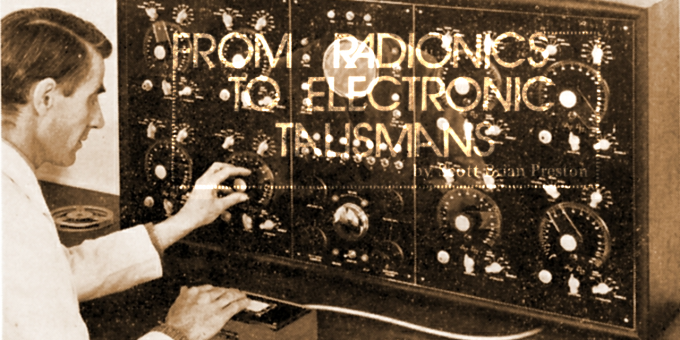
VII
Cure or Curse?
Using a telescopic device. Hieronymus tried drawing down eloptic energy from distant stars and planets. What he was doing with this energy I do not know. In recent years he has closely guarded his experiments. One observer told me that his silence was to preserve a discovery that, in the wrong hands, could be “rather dangerous.”
In September, 1972, Saga magazine printed “The Incredible Hieronymus Machine — Ultimate Doomsday Device . . . ?” It was one of the first statements to the effect that maybe radionics was not all harmless fun. When I first occasioned an inquiry into some serious research. I was sternly warned by a researcher: “Keep your nose out of radionics! There are big poker games and little poker games and radionics is a big poker game.” He later confided that there was a weapon potential involved.
I was reminded of those sinister stories by H. P. Lovecraft, where a barely sane Crawford Tillinghast builds a machine that is “not electrical in any sense you can understand” and is capable of “drawing down demons from the stars . . .things that stride from world to world sowing death and madness.” If radionics can affect people at a distance with nothing more than a lock of hair or photograph, then a frightening question looms on the horizon. Can it be used to curse as well as cure?
VIII
U.K.A.C.O.
This brings us back to the photograph and the farmer’s field. The question is, how well does radionics work on insects? There are conflicting reports on this. The Department of Agriculture claims to have investigated radionics, but they really did not devote any time to it at all; they just assumed that since it was weird it could not exist. Two men from the department were passing through Pennsylvania when they were asked to drop in to see tests being done in radionics. They spent one day, hardly long enough to observe anything, and beat it back to their air-conditioned offices to write up facile reports.
On the other hand, the Pennsylvania Farm Cooperative Bureau was more objective. For three years they took part in tests conducted in various parts of the state by a company called U.K.A.C.O., which was founded by three men: Upton, Knuth and Armstrong.
[Curtiss Upton was the son of a research associate of Thomas Eidison; Upton took a degree in engineering from Princeton. William J. Knuth is an electronics and radio engineer. Howard Armstrong is a metallurgist and chemical engineer with a degree from Princeton and a long, successful record with the Dow Chemical Company. Brigadier General Henry M. Cross, U.S.A. (Ret’d.), is also part of the company; he was trained in mechanical engineering.]
U.K.A.C.O. used aerial photographs of the fields and were 80 per cent effective in controlling Japanese beetles. Corn borers were destroyed or repelled at a rate of about 55 per cent. When Hieronymus used a version of the bug-killer on corn borers contained in a terrarium, he actually liquefied the bodies of those in the experimental group.
Fields that were radiated with just the photo alone showed greater crop yields. Potato yields were an average of 16 per cent higher than crops treated with chemical sprays to promote growth.
Impressed with these results, the State Government of Pennsylvania contributed $25,000 to the research and development of radionics in agriculture.
In 1950 the company contracted with 44 California artichoke-growers to treat their crops against plume moths. It was agreed that if the moth was not satisfactorily controlled, they did not have to pay. The insects were controlled and all the growers paid a mere one dollar an acre — a fraction of the cost of spraying.
All of this is, of course, tremendous news for ecologists, but in counties where the experiments were performed, the sale of insecticide plummeted. A strong lobby was sent to the state legislature and a damper was put on the project for many years.



